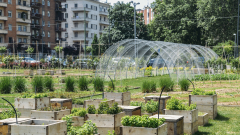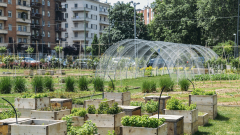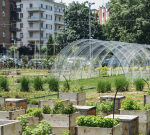
Get the Popular Science daily newsletter💡
Good news… at least relatively speaking. In the event of a catastrophic event like a nuclear attack or solar storm, an average-sized city’s (surviving) population doesn’t necessarily require a huge amount of nearby farming space to sustain itself. While the findings detailed in a study published May 7 in the journal PLOS One may seem a small comfort, emergency preparedness research can offer urban planners and government authorities valuable information on how to plan contingencies for an absolute worst case scenario.
Assessing global catastrophic risks
Certain nightmare events will be nearly impossible to endure as a species. For example, total nuclear war could easily render the planet inhabitable for the vast majority of life, including humans. The same can be said for an efficiently evolved supervirus or massive asteroid strike. While these are horrific to consider, more localized catastrophes like a dirty bomb’s radioactive fallout or a major solar storm frying a regional electrical grid are arguably more likely. But as scary as those still are, immediate survivors could endure and recover if they adopt strategic urban and near-urban agricultural practices.
“Abrupt global catastrophic risks (GCRs) are not improbable and could massively disrupt global trade leading to shortages of critical commodities, such as liquid fuels, upon which industrial food processing, processing, and distribution depends,” the authors wrote in the study.
Previous work frequently examined urban agriculture techniques such as community, home, and rooftop gardens for resiliency planning. However, catastrophic risk consultant Matt Boyd argues that people need to broaden their scope if they hope to weather any potential dystopian lean times.
“During a global catastrophe that disrupts trade, fuel imports could cease, severely impacting the industrial food production and transportation systems that keep our supermarket shelves filled,” Boyd said in the study’s accompanying statement. “To survive, populations will need to dramatically localize food production in and around our cities. This research explores how we might do that.”
Peas, potatoes, sugar beets, and spinach
Boyd and co-author Nick Wilson at the University of Otago chose the New Zealand city of Palmerston North as their study’s post-apocalyptic scenario backdrop. Located on the North Island near the Manawatū River, Palmerston (Palmy, colloquially) is representative of many cities around the world, with a largely temperate climate and a population of around 91,000 residents. After analyzing Google Earth maps of the area to tally Palmy’s residential lots and open city spaces that could be used for crops, they concluded that even at optimal yields, the city would likely only provide about 20 percent of the food needed to survive.
But that’s not necessarily cause for despair. If the community dedicated at least 4.4 square miles of surrounding land to additional agricultural projects, that would close the gap for adequate food stores. What’s more, only about 0.4 square miles of extra land would be needed for the biofuel required to power agricultural machinery.
The team even offered a few helpful crop suggestions depending on your scenario: a “normal climate,” as well as “potential nuclear winter conditions.” Under current normal climatic patterns, urban gardens should concentrate on peas given their protein and calorie contents versus land requirements, while potatoes are the best bet for surrounding farmland. In the nuclear winter scenario, cities would need to focus on sugar beets and spinach, while near-urban plots handle wheat and carrots.
Societal-level cooperation
Boyd and Wilson have written extensively about how island communities and nations could serve as refuges






